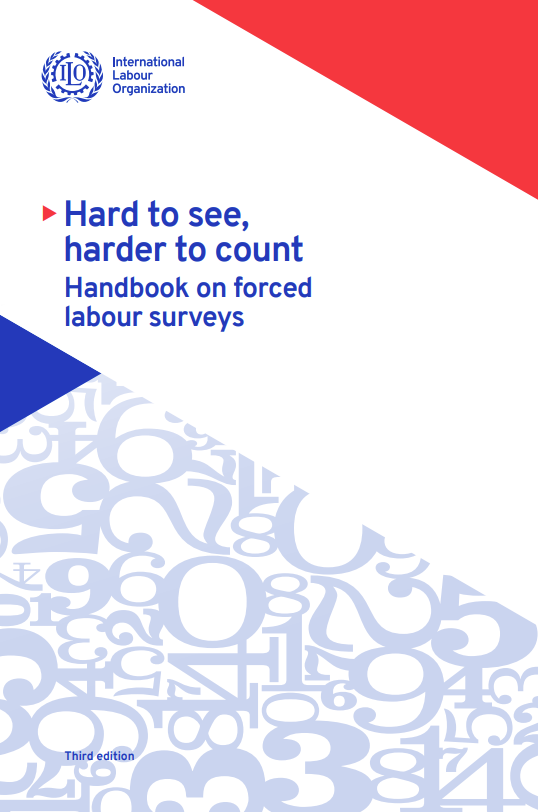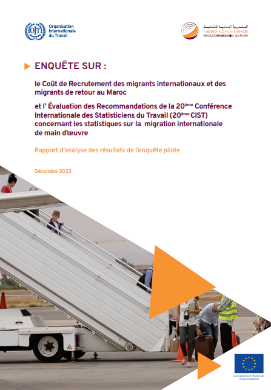ECOWAS and Partners Advance Labour Migration Data Systems at Regional Meeting in Nigeria
Posted at December 3rd 2025 12:00 AM | Updated as of December 3rd 2025 12:00 AM
Region/Country :
|Themes : ,
Hard to see, harder to count: Handbook on forced labour surveys
This revised version of the "Hard to see, harder to count" handbook provides an updated set of tools for the design, implementation and analysis of quantitative surveys on the forced labour of adults.
Data collection and analysis lie at the heart of sustainable action to combat forced labour. Reliable statistics are essential to understand the nature and extent of the problem, its causes and consequences, and to inform the efforts of policy-makers and other stakeholders against forced labour. Regular data collection also enables the assessment of progress and impact of policy implementation, action plans and specific programmes and projects to eradicate forced labour.
The 20th International Conference of Labour Statisticians (ICLS) in 2018 endorsed, for the first time, Guidelines Concerning the Measurement of Forced Labour. In 2022, the ILO, Walk Free and the International Organization for Migration (IOM) published “Global Estimates of Modern Slavery: Forced Labour and Forced Marriage”. This was the fourth effort by the ILO to produce global regional estimates of forced labour (2005, 2012, and 2017) and the first global estimates published after the adoption of the ICLS Guidelines. In addition, a total of 17 national and sectoral forced labour prevalence surveys have been undertaken with ILO support since 2018.
In 2012, the ILO published the handbook Harder to See, Harder to Count, the first practical guidance on forced labour prevalence surveys. Based on new ICLS guidelines, and drawing on the lessons learnt from the subsequent global estimates exercise and forced labour prevalence surveys, this version 2.0 of the Hard to See, Harder to Count handbook presents an updated measurement framework and set of tools for the design, implementation and analysis of surveys of forced labour. The revised handbook presents a new unified set of core indicators of involuntary work and coercion and contains two new dedicated chapters, one on research ethics and the other on state-imposed forced labour.
Starting with an introductory discussion of legal and conceptual frameworks (Chapter 1), the handbook takes a researcher sequentially through all the key stages of a forced labour survey, from initial stakeholder consultations, the conduct of a preliminary scoping study, and the identification of the survey scope and research questions (Chapter 2), to the selection of the survey type and modality (Chapter 3), sample design (Chapter 4), questionnaire design (Chapter 5), fieldwork (Chapter 6) and finally to data analysis (Chapter 7). It also covers key ethical considerations across all these survey stages (Chapter 8). Chapter 9 offers specific guidance to researchers for the measurement of state-imposed forced labour.
Type of document :
Country/Region :
Year of publication :
Theme : ,
Measuring Sustainable Development Goal indicator 10.7.1 on the recruitment costs of migrant workers: Results of the 2019 Philippine survey on overseas Filipinos
The report presents an assessment of the pilot process on measuring SDG indicator 10.7.1, undertaken by the Philippine Statistics Authority (PSA) in collaboration with the ILO.
The survey findings provide an indication on the burden of recruitment costs to overseas Filipino migrant workers. Results shed light on possible impacts of existing policies to protect Overseas Filipino Workrs (OFWs) as well as indicating future areas and target groups of policy focus when tackling issues related to high recruitment fees and related costs of Filipino migrant workers going to work abroad.
Type of document :
Country/Region :
Year of publication :
Theme : , , ,
Somalia and South Sudan Join Efforts to Design Labour Force and Migration Surveys
Posted at October 21st 2025 12:00 AM | Updated as of October 21st 2025 12:00 AM
Region/Country :
|Themes : ,
National Workshop on the Harmonization of Concepts and Definitions of Labour Migration Statistics in Ghana
Posted at September 4th 2025 12:00 AM | Updated as of September 4th 2025 12:00 AM
Region/Country :
|Themes : ,
Enquête sur le coût de recrutement des travailleurs migrants internationaux et de retour au Maroc
Cette enquête a pour objectif de valider la conception des modules d’enquête nécessaires à la production de statistiques conforment aux recommandations de la 20ème CIST concernant les statistiques sur la migration internationale de main d’oeuvre et aux directives de l’Organisation Internationale du Travail (OIT) et de la Banque Mondiale sur les coûts de recrutement.
-----------------------------------------------------------------------------------------------------------------------
Suite à la signature du protocole d’accord entre l’OIT et le Haut-Commissariat au Plan (HCP) du Maroc , des travaux ont été menés pour établir un système global de statistiques sur les migrations de main-d’oeuvre. Ce système doit assurer le suivi et l’élaboration de politiques fondées sur des données probantes, tel que souligné dans le Pacte mondial sur les migrations et l’Agenda des objectifs de béveloppement durable. Dans ce cadre, un ensemble d’activités d’assistance technique sont mises en œuvre par l’OIT pour accompagner le HCP dans la refonte de l’Enquête nationale sur l’emploi.
Des interventions stratégiques et de nouveaux outils sont en cours de développement pour produire des statistiques visant à documenter et améliorer la gouvernance des migrations de main-d’oeuvre.
L’objectif de ce rapport est d’évaluer la conception des modules pour produire des statistiques sur migration de main-d’œuvre, en tenant en compte principalement (1) des dernières recommandations de la Conférence internationale des statisticiens du travail (CIST) concernant les statistiques du travail et (2) du calcul de l’indicateur de l’Objectif de développement durable (ODD) 10.7.1, qui mesure les coûts de recrutement des travailleurs migrants internationaux et des travailleurs migrants de retour.
Ces données faciliteront l’élaboration de politiques efficaces, qui protègent les droits des travailleurs migrants et assurent une bonne gestion de la migration de main d’œuvre, tout en promouvant le développement durable dans les pays d’origine et de destination.
Type of document :
Country/Region :
Year of publication :
Theme : ,
Gender equality in labour migration law, policy and management (GEM Toolkit)
The Gender equality in labour migration laws, policy and management GEM Toolkits is a set of nine practical tools, developed by the International Labour Organization (ILO) to facilitate the implementation of gender mainstreaming strategies in labour migration and related employment, social protection, and equality laws, policies, programmes, projects, as well as in day-to-day labour migration management practices.
The overall purpose of the GEM Toolkit is to contribute to eliminating discrimination against low-income women migrant workers in employment and occupation, and to shaping more gender-responsive labour migration laws, policy, and management in ASEAN for the benefit of both women and men migrant workers.
Type of document :
Country/Region : , , , , , , , , ,
Year of publication :
Theme : , , ,
2019 Recruitment Costs Pilot Survey Report-Ghana, Measuring SDG Indicator (10.7.1)
This report presents the survey results and examines the recruitment costs, monthly earnings, and Recruitment Cost Indicator (RCI) of migrant workers taking into account their socio-demographic characteristics such as age, occupation, the industry of work, educational attainment, skills, and gender.
In 2019, the Ghana Statistical Service conducted the Recruitment Cost Pilot Survey (RCPS) in four administrative districts, namely, Mampong Municipal, Asante Akim North in the Ashanti Region, and Berekum and Techiman in the Bono and Bono East regions, respectively. The study was mainly designed to pilot an ILO recommended survey methodology to collect data on recruitment costs and monthly earnings of migrant workers from purposely selected districts, in a bid to calculate the SDG indicator 10.7.1 (Recruitment Cost Indicator). This report, therefore, presents the survey results, as it examines the recruitment costs, monthly earnings, and Recruitment Cost Indicator (RCI) of migrant workers taking into account their socio-demographic characteristics such as age, occupation, the industry of work, educational attainment, skills, and sex.
The results of this pilot study show that the survey methodology adopted for this study is suitable for estimating the RCI as required for measuring the SDG indicator 10.7.1. The study shows that the RCI levels, derived from average recruitment costs and monthly earnings for migrant workers, could plausibly be a function of skill level, country of destination, or educational level of the migrant worker. This is because lower levels of RCI could be associated with highly-skilled workers, highly educated migrant workers, and developed countries due largely to commensurate high monthly earnings, a result that resonates with our a-priori expectation.
The Ghana Statistical Service (GSS) implemented the study in collaboration with the International Labour Organization (ILO) with funding from the European Union.
Type of document :
Country/Region : ,
Year of publication :
Theme : , , , ,
Subscribe to the Fair Recruitment Initiative Newsletter
Sign up to receive news delivered to your inbox.





